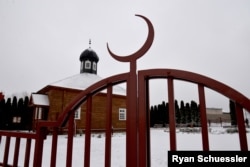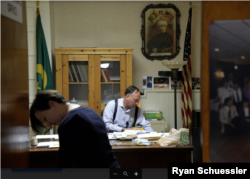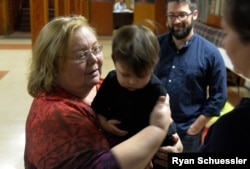BROOKLYN, New York -- Standing in an office cluttered with papers, old photographs, and ledger books, Marion Sedorowitz sorts through the week's mail sent to her mosque in Brooklyn's Williamsburg neighborhood.
Behind her hangs a portrait of an imam, sitting stoically with his hands crossed, flanked by illustrations of the U.S. flag and a green flag bearing the Islamic crescent moon and star -- with the Polish coat of arms wedged in between. At the bottom, in dark gothic letters, is written: "Dr. J. Szynkiewicz, Mufti of Poland Republic."
A Lipka Tatar -- a Muslim ethnic group native to the Baltic region -- Jakub Szynkiewicz was selected to be Poland's first mufti in 1925, around the time that his community's U.S. diaspora was moving into the very mosque in Brooklyn where his portrait still hangs. Contact, exchange, and travel between the Lipka Tatar communities and their American cousins -- the norm since American Lipka Tatars formally organized in 1907 -- came to a screeching halt in 1938 when Germany invaded Poland. Then the Iron Curtain fell between them for decades more. For Brooklyn's Lipka Tatars, this meant being isolated from the communities that had sustained their culture for centuries.
Now, things are changing. As another generation of American Lipka Tatars ages, the dwindling community's younger leaders are reaching out to Europe for the first time in generations. Thanks to the Internet, their European kin are finally able to reach back.
"The people I've spoken to in Poland and Belarus, they're seeing a lot of the same things that we're seeing as far as decreased membership, as well as a general fascination with our history," says Alyssa Haughwout, the 32-year-old caretaker of the Brooklyn mosque and a third-generation American of Lipka Tatar descent. "It's happening in Brooklyn and it's happening in Lithuania. That's something. If we can learn anything about how they're doing, how they're being successful about bringing people to the mosque, and sustaining this cultural touchstone, that would be valuable."
While Lipka Tatar congregations are dwindling, general interest in their history is increasing. When U.S. reports suggested Islamophobic incidents were multiplying in 2016, the Brooklyn mosque's profile grew as an example of Islam's deep roots in the United States. In Europe, "I observe more and more visitors every year," Polish historian and guide Anna Krasnicka wrote in an e-mail from Poland's Podlaskie region, home to two historic, wooden Lipka Tatar mosques. "They are more interested in multicultural face of [Podlaskie], which means not only Tatars but also Orthodox community and Jewish heritage."
Krasnicka added: "Also people are attracted by Tatars' cuisine, which is really interesting, tasty, and unusual."
Lipka Tatars are descendants of 14th-century Turkic settlers to the Baltic region whose practice of Islam has taken on a local flavor. Mosques are traditionally constructed out of wood, sometimes shaped like churches. Historically, the community spoke Belarusian but wrote the language in Arabic script -- a practice that lasted until World War II. Haughwout has heard stories of Lipka Tatars covering their mirrors with blankets during Ramadan, reminiscent of the Jewish practice of sitting Shiva. Lipka Tatars' meaty, hearty cuisine has a growing profile in Poland, which is nearly 95 percent Roman Catholic.
Like most religious institutions, the Lipka Tatars' Muslim centers suffered under decades of secular communist rule in the Soviet Union. The Iron Curtain also cut them off from the American diaspora, which was able to practice its faith freely.
"It was a very difficult time," recalls Marion Sedorowitz, a lifelong member of Brooklyn's historic Lipka Tatar mosque. "I do recall we would try to send things over there during the Cold War, but a lot of stuff didn't make it there."
But the tables are turning.
Lipka Tatars in Europe have enjoyed a cultural and religious renaissance in the decades following the collapse of the Soviet Union. Cultural centers and mosques have been built in several villages and towns. In the Polish city of Bialystok, where the mufti of Poland is based, Lipka Tatars have also started to relearn the Tatar language.
Haughwout and Sedorowitz hope that their American congregation can tap into Europe's Tatar renaissance to revitalize their mosque. While the membership of the U.S. mosque represents around 100 families, an average of around a dozen people attend the few religious services held there. Most of the time, the mosque is closed. It has been decades since a Lipka Tatar imam served the congregation.
"All of that has to change," Marion Sedorowitz says of the mosque's dwindling congregation. "In order for us to be anywhere successful, we have to put ourselves out there."
Marion's husband, Jack Sedorowitz, adds: "If we had some of our relatives or community from the European countries come here, I think we would embrace them. I think that would be the ideal of what could happen."
Marion, who comes from a long line of imams, answers: "Or even having an imam come here, and we could sponsor them. But we need to have a congregation. We have to really move it."
In 2015, the communities took a momentous step toward renewing ties. The modern mufti of Poland -- Tomasz Miskiewicz -- visited the Brooklyn mosque and the Sedorowitzes for the first time.
"It was interesting," Marion Sedorowitz recalls. "We did have a language barrier, but you could see from him, and his features, that he would fit in our mosque. He was one of us. And that in itself is a really strong bond."
In an interview in his office in April 2015, Miskiewicz spoke briefly of his visit with the Sedorowitzes and to the Brooklyn mosque, where relatives of his were once members. "I want to cooperate with the American Tatars," he said.
What that cooperation looks like remains to be seen, but it is a relationship that both parties are eager to explore.
Haughwout and the Sedorowitzes are in the process of planning a group trip to Europe to meet the European Lipka Tatars and visit their ancestral villages. Dzenneta Bogdanowicz, a Lipka Tatar restauranteur in the Polish village of Kruszyniany, said the Americans would be enthusiastically welcomed.
"It's just baby steps right now," Marion Sedorowitz says. "I just think the connection of family -- maybe renewing ties that have long been lost. And I don't know what can go from there, but I think it's a step towards making these connections and seeing where it can go."
She adds: "There's so many steps in between, but I guess [the goal] would ultimately be to have somebody here, being sponsored, and have all this reactivated, but for all Muslims, not just for Tatars."
"Renewed contacts probably means more events, more traveling between countries, but for sure it can open a new chapter for some families," Krasnicka wrote.
In the meantime, Haughwout, who is the youngest member of the mosque's governing board, has tapped into digital Tatar spaces. Not just for Lipka Tatars, but networks that encompass Tatar communities in Crimea, Russia, and beyond -- communities once on the other side of the Iron Curtain, now just a Facebook message away.
"It seems like the right thing to do," Haughwout says. "It seems like there's something to be gained."




